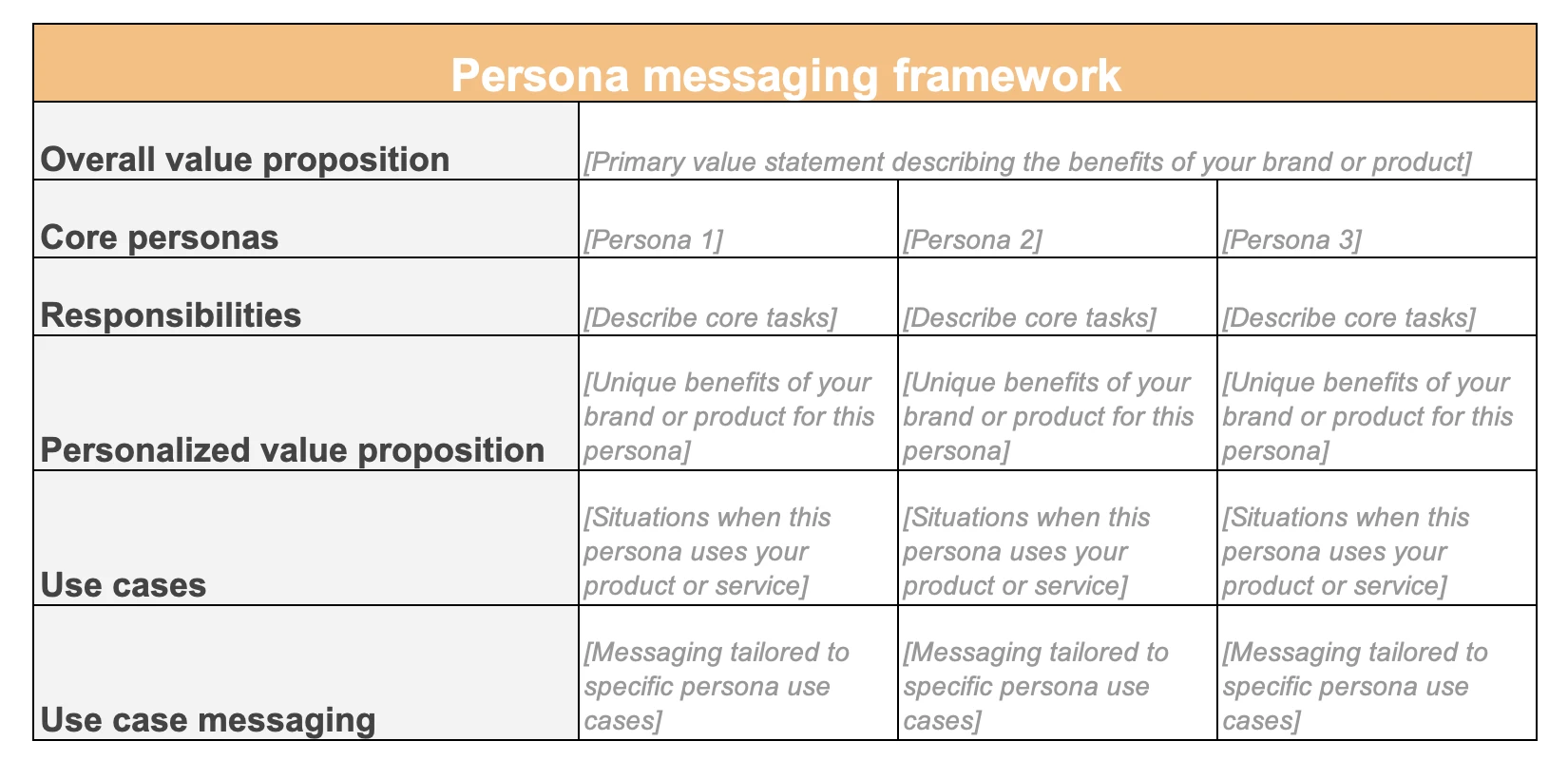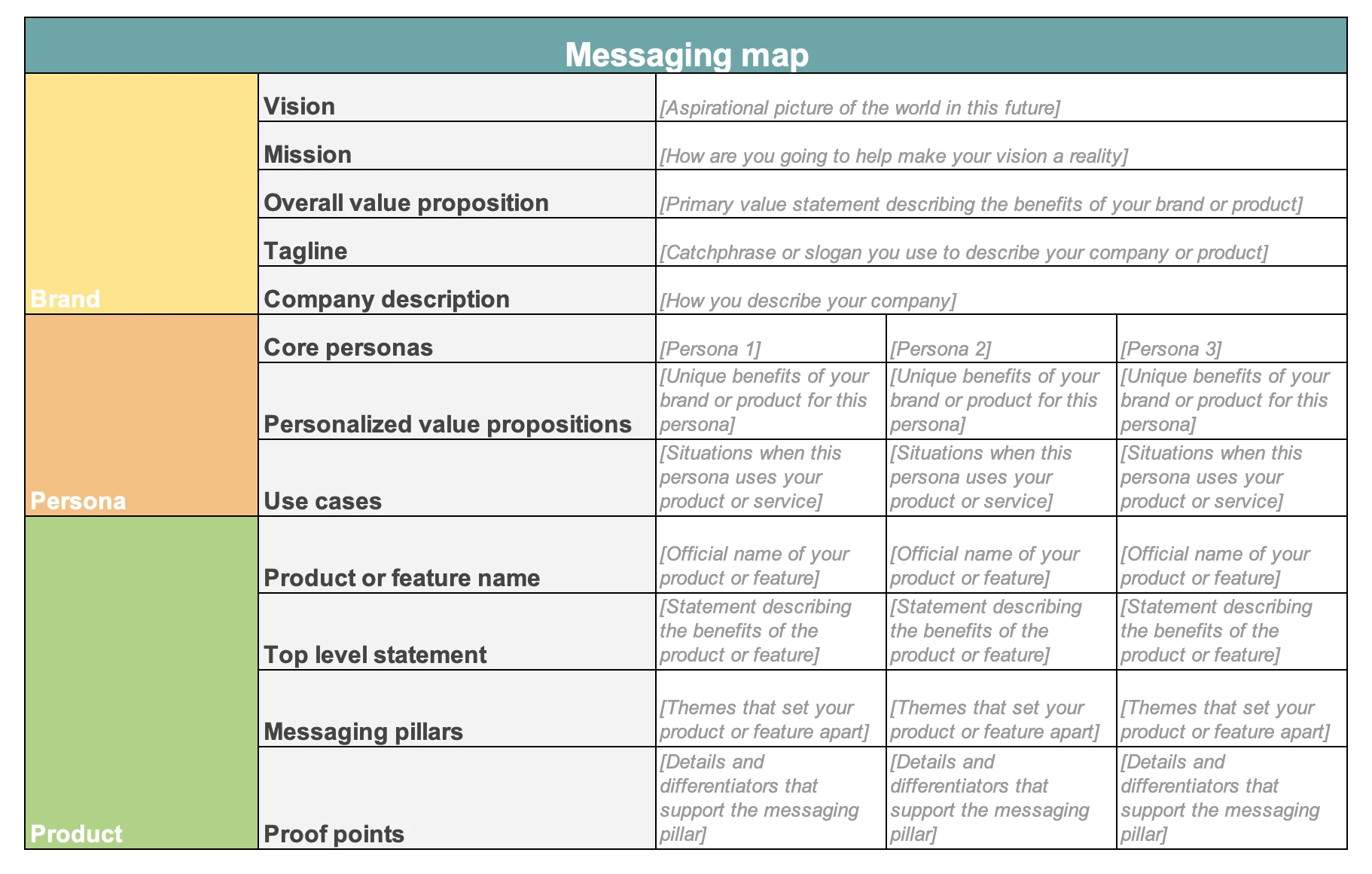6 marketing messaging templates for teams
How do you stand out in a crowded market? It starts with knowing your audience — who they are, what they care about, and the problems they want to solve. You can use this knowledge to craft marketing messages that truly speak to buyers and engage existing customers.
Most marketers recognize the importance of brand and product messaging. When you define what sets you apart, you can better tell the story of your brand and describe the value of your product. But it can be challenging to get everyone aligned on core messaging. You are hustling to launch new marketing activities and campaigns — the tactical details take over.
It is also common for marketing content to go through multiple versions, formats, and reviewers before it is finalized. If you do not have a set of core messages or content pillars for everyone to rally around, your content can become disjointed and diluted during these production cycles. That will make it less compelling for your audience to read, listen, or try your product.
Templates help you build a messaging hierarchy by deconstructing it into smaller elements, such as a value statement, core concepts, and proof points. This exercise helps you channel your customer's mindset and deeply consider what they value. Templates ensure consistency across all the teams that develop content — improving clarity and your ability to launch more swiftly. That alone is worth celebrating.
Jump ahead to any section:
What are the benefits of marketing messaging?
Well-defined messaging contributes to strong brand identity. It requires you to get clear on what the organization's vision is. Then you can translate both your vision and your values into meaningful, practical messages that will shine through in each customer communication. Messaging impacts buyer perceptions and, ultimately, business growth.
Having a set of core marketing messages allows you to:
Align internally around a shared story: Collaborate and reflect on the real value you provide. This exercise helps everyone better understand your product and how it meets customer needs.
Deliver a consistent message across all channels: Showing what you stand for (and making it memorable) takes repetition.
Differentiate from competitors: Customers in the digital age have more options than ever. Clear messaging gives you a distinct identity.
Make room for future experimentation: A great messaging framework provides a foundation from which you can branch out. Once you have developed core content pillars, you can add and test additional messages.
How does messaging differ from positioning?
Communicating the value of your brand or product requires both positioning and messaging. These are distinct and complementary concepts:
Positioning is an internal exercise that you complete as an organization or team. It helps you articulate the unique benefits of your brand, product, or service.
Messaging is external. It is how you translate the positioning into content to reach your customers.
Positioning helps shape messaging — it remains consistent over time. Messaging can change based on current campaigns or areas of focus. But there is an added layer of complexity because some organizations create positioning and messaging at the company or brand level, as well as for each product. Here is a breakdown:
Who it is for | What it does | Who is responsible | |
Marketing positioning | Internal teams | Establishes the values and perceptions of your brand | Corporate marketing |
Product positioning | Internal teams | States the unique benefits of your product and why it is better than what your competitors have to offer | Product and product marketing |
Marketing messaging | External customers and prospects | Translates market positioning into key messages that will resonate with your audience | Corporate marketing |
Product messaging | External product and customers | Translates product positioning into product messaging about use cases, core functionality, and features | Product marketing |
What should be included in marketing messaging?
Effective messaging requires close alignment between marketing and product management teams, as well as a deep understanding of your target customers. Messaging frameworks vary by organization but typically contain the following components:
Value proposition or tagline: Primary value statement or tagline used to describe the benefits of your brand or product
Messaging pillars: The most important themes you will communicate to set your brand or product apart
Proof points: Details and differentiators that bring credibility to the messaging pillars — such as technology, design, or customer service
Target audience: The buyer personas you serve
Use cases: Essential ways customers use your product to solve problems
Messaging frameworks follow a top-down hierarchy. Start with the value statement that describes how your brand or product is unique, develop messaging pillars that support the value statement, and add proof points to support those pillars.
Of course, you can customize your messaging based on your strategic plans and marketing goals. Some marketing teams choose to combine positioning and messaging within the same framework.
Core messaging statements
Use this simple template to define core marketing messages — the statements that will become your tagline or messaging pillars. Think of these messages as the building blocks that support all of your marketing efforts.
Related:
Messaging templates
The six templates included below give you a foundation for building marketing messages. You can add to and customize each to fit your organization's needs.
Core messaging statements
Use this simple template to define core marketing messages — the statements that will become your tagline or messaging pillars. Think of these messages as the building blocks that support all of your marketing efforts.
Brand messaging
Expand on your core messaging with additional elements — such as proof points and target audience. This template combines internal and external messages so you can connect the dots between each.
Brand messaging
Expand on your core messaging with additional elements — such as proof points and target audience. This template combines internal and external messages so you can connect the dots between each.
Messaging matrix
Create distinct messaging by audience type and channel (email, social, paid ads) using a messaging matrix. This is useful when developing content to reach prospects and customers at different stages in the customer journey.
Persona messaging
Use this template to develop unique messaging that will resonate with each customer segment or persona. Some personas will have overlapping needs and pain points, while others will be more discrete. Develop a top-level message that resonates with all of them.
Product messaging
Launching a new product? Get aligned on the most important messages that demonstrate its value. You may want to differentiate between top-level messaging (e.g., benefits and outcomes) and feature-level messaging.
Product messaging
Launching a new product? Get aligned on the most important messages that demonstrate its value. You may want to differentiate between top-level messaging (e.g., benefits and outcomes) and feature-level messaging.
Product messaging map
This messaging map combines brand messaging, persona messaging, and product messaging — it is a great way to evaluate messages alongside one another. It is especially useful if you market multiple products.
These templates provide lightweight frameworks for getting started. In time, you might find that you outgrow Excel templates and need a more sophisticated, collaborative messaging framework. Try Aha! Roadmaps to get access to strategic templates, automated workflows, and marketing roadmaps.
Build marketing plans like you always wanted. Sign up for a free 30-day trial.



